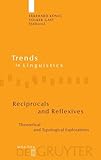Reciprocals and Reflexives : Theoretical and Typological Explorations / ed. by Ekkehard König, Volker Gast.
Material type: TextSeries: Trends in Linguistics. Studies and Monographs [TiLSM] ; 192Publisher: Berlin ; Boston : De Gruyter Mouton, [2008]Copyright date: ©2008Description: 1 online resource (652 p.)Content type:
TextSeries: Trends in Linguistics. Studies and Monographs [TiLSM] ; 192Publisher: Berlin ; Boston : De Gruyter Mouton, [2008]Copyright date: ©2008Description: 1 online resource (652 p.)Content type: - 9783110195941
- 9783110199147
- 415
- P299.R38 R45 2008
- online - DeGruyter
- Issued also in print.
| Item type | Current library | Call number | URL | Status | Notes | Barcode | |
|---|---|---|---|---|---|---|---|
 eBook
eBook
|
Biblioteca "Angelicum" Pont. Univ. S.Tommaso d'Aquino Nuvola online | online - DeGruyter (Browse shelf(Opens below)) | Online access | Not for loan (Accesso limitato) | Accesso per gli utenti autorizzati / Access for authorized users | (dgr)9783110199147 |
I-VI -- Contents -- Abbreviations and glosses -- Reciprocity and reflexivity – description, typology -- and theory -- Reciprocal constructions: Towards a structural -- typology -- Constructions expressing middle, reflexive and -- reciprocal situations in some Oceanic languages -- The intersection between reflexives and -- reciprocals: A grammaticalization perspective -- Reflexive encoding of reciprocity: Cross-linguistic -- and language-internal variation -- Distinguishing reciprocals from reflexives in Kuuk -- Thaayorre -- Valency-changing operations in Wolof and the notion -- of “co-participation” -- On reciprocal and reflexive uses of anaphors in -- German and other European languages -- Thoughts on the origin, progress, and pronominal -- status of reciprocal forms in Germanic, occasioned by those of -- Bavarian -- Irreducible symmetry in reciprocal -- constructions -- The inherently reflexive and the inherently -- reciprocal predicate in Hungarian: Each to their own argument -- structure -- The Syntax of Reciprocal Verbs: An Overview -- Anaphoric dependencies: How are they encoded? -- Towards a derivation-based typology -- Domain restrictions on reciprocal -- interpretation -- A binding theory exempt anaphor -- From intensive to reflexive: The prosodic -- factor -- 633-652
restricted access online access with authorization star
http://purl.org/coar/access_right/c_16ec
This collection of original papers is a representative survey of recent theoretical and cross-linguistic work on reciprocity and reflexivity. Its most remarkable feature is its combination of formal approaches, case studies on individual languages and broad typological surveys in one volume, showing that the interaction of formal approaches to grammar and typology may lead to new insights and results for both fields. Among the major issues addressed in this volume are the following: How can our current knowledge about the space and limits of variation in the relevant domain be captured in a structural typology of reciprocity? What light can such a typology shed on the facts of particular languages or groups of languages (e.g. Austronesian)? How can recent descriptive and typological insights be incorporated into a revised and more adequate version of the Binding Theory? How do verbal semantics, argument structure and reciprocal markers interact? How can we explain the pervasive patterns of ambiguity observable in these two domains, especially the use of the same forms both as reflexive and reciprocal markers? What are the major sources in the historical development of reciprocal markers? This combination of large-scale typological surveys with in-depth studies of particular languages provides new answers to old questions and raises important new questions for future research.
Issued also in print.
Mode of access: Internet via World Wide Web.
In English.
Description based on online resource; title from PDF title page (publisher's Web site, viewed 28. Feb 2023)


